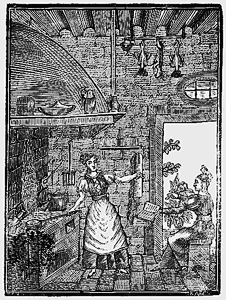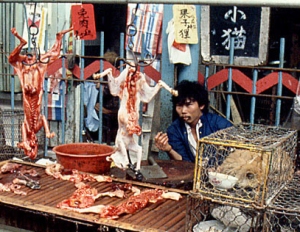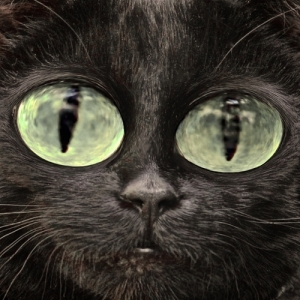One of the most memorable sayings you learn when you first study Spanish is, “Dar/vender gato por liebre,” or to “give or sell a cat instead of a rabbit,” meaning deception.
 Digging into the history of Spanish cookbooks, you’ll find a famous — and oft-quoted — recipe for roast cat in Ruperto de Nola’s* fifteenth-century opus: Libro de cocina compuesto por maestre Ruberto de Nola cocinero que fue del sereníssimo señor Rey don Hernando de Nápoles …,** thankfully also known as El Llibre del Coch for short, a much more manageable mouthful. (The link leads to the 1580 version.)
Digging into the history of Spanish cookbooks, you’ll find a famous — and oft-quoted — recipe for roast cat in Ruperto de Nola’s* fifteenth-century opus: Libro de cocina compuesto por maestre Ruberto de Nola cocinero que fue del sereníssimo señor Rey don Hernando de Nápoles …,** thankfully also known as El Llibre del Coch for short, a much more manageable mouthful. (The link leads to the 1580 version.)
The recipe goes like this:***
You take a fat cat, and cut its throat, and after it is dead, behead it and throw the head away, because it is not something to be eaten because it is said that those who eat the brains will lose their minds and lack judgment.
After cleanly skinning the cat and gutting it and washing it well, wrap the carcass in a clean linen cloth and bury it in the ground, leaving it for a day and night, then take it out of the ground and roast it on a spit over a fire, and when it begins to cook, rub it with garlic and olive oil; once it is smeared well with the garlic and oil, take a green branch [switch] and hit the meat until it is well roasted, continuing to smear it with oil, and when the meat is done, cut it up as for rabbit or goat, and put the meat on a large plate, taking garlic and oil boiled in thin broth, and pour this over the cat, and you can eat this because it is a good dish. (Translated by C. Bertelsen)
Think of the cat’s temporary burial as something to do with tenderizing the flesh through aging (and elimination of rigor mortis), similar to hanging game. Likewise, the use of the green-wood switches (or twigs) may be another possible tenderizing method.
A poem written by José Fernández Bremón,”Gato por Liebre,” takes Nola’s recipe a step further, embellishing it and setting to poetical rhythms.
According to most authorities, recipes for cat rarely appear in cookbooks. Hence, the uniqueness of de Nola’s recipe.
 Yet people do eat cat; take China for example. Recent news suggests that the eating of cats is fairly widespread, particularly in southern China. Westerners perceive cat-eating as being a common act, but not so, according to E. N. Anderson in The Food of China (1988) and K. C. Chang in Food in Chinese Culture: Anthropological and Historical Perspectives (1977), the dish “Dragon, Tiger, and Phoenix”**** to the contrary. And even in cultures where very strong taboos exist against eating cats, under trying circumstances — war, siege, and famine, and likely poverty, too — cats likely appeared in cooking pots or on roasting spits.
Yet people do eat cat; take China for example. Recent news suggests that the eating of cats is fairly widespread, particularly in southern China. Westerners perceive cat-eating as being a common act, but not so, according to E. N. Anderson in The Food of China (1988) and K. C. Chang in Food in Chinese Culture: Anthropological and Historical Perspectives (1977), the dish “Dragon, Tiger, and Phoenix”**** to the contrary. And even in cultures where very strong taboos exist against eating cats, under trying circumstances — war, siege, and famine, and likely poverty, too — cats likely appeared in cooking pots or on roasting spits.
And in Spain in the early twentieth century, according to a Basque cook and food writer, José Castillo, families cooked cat stew. A recipe recorded in Castillo’s Recetas de la Cocina de las Abuelas Vascas (1995) from an informant over 90 years old in the early 1980s reads:
Skin it, gut it and hang it in the open air for one night. The next day, cut it up, place the pieces into a pot and add some chopped garlic, salt, thyme, red wine, a cup of vinegar and a cup of oil. Leave the pot out in the open all night and the next day place it close to the fire and let the meat cook slowly, until it is tender.
One time in Africa, it seemed certain that a cat of ours ended up in someone’s stew pot during a feast-day period. Peter Biddlecombe, a travel writer (French Lessons in Africa: Travels with My Briefcase Through French Africa) talks about eating cat meat in Benin, quoted in The Congo Cookbook:
Cats in this part of the world don’t live long enough to get plump. They are considered such a delicacy people can’t wait for them to grow fat. Either their own or other people’s — they think nothing of snatching a neighbor’s cat for dinner. If you can’t catch your neighbor’s cat, you can always buy one in the market.
In the final analysis, De Nola’s recipe reminds us of the way in which we view animals as either companions or as food. One characteristic that seems to preclude humans eating certain animals (not all, mind you) is whether or not the animal in question also eats meat. Cats are carnivorous. They eat animals, like rats and mice, that humans won’t normally touch to their tongues. Eating companion animals feel similar to eating family members, whereas other animals, depersonalized, made Other, are fair game, so to speak.
 But you might well wonder if there’s more to this seemingly innate taboo against eating cat meat. First of all, some societies associated cats with the divine, as in ancient Egypt. And other societies link cats with the occult.
But you might well wonder if there’s more to this seemingly innate taboo against eating cat meat. First of all, some societies associated cats with the divine, as in ancient Egypt. And other societies link cats with the occult.
Looking at cookbooks like de Nola’s often raises many questions about what is edible and what is not edible, leading to more questions about how societies determine what is edible and what is not.
Italian chef Giuseppe “Beppe” Bigazzi recently landed in the stew for stating that cat meat worked well in stew. The furor stirred up confirms that different people hold different views on what is edible and what is not.
Very interesting, since Alan Davidson believed that Rupert de Nola’s work greatly influenced the cuisine of Italy.
Caveat: A lovely gray/white cat named Jane lives with me, so I am frankly somewhat biased against cooking cats for dinner.
_______________________
*Also known as Robert de Nola, Rupert di Nola, Mestre Robert, etc.
**Full title:
Libro de cocina compuesto por maestre Ruberto de Nola cocinero que fue del sereníssimo señor Rey don Hernando de Nápoles, de muchos potajes y salsas y guisados para el tiempo del carnal y de la quaresma, y manjares y salsas y caldos para dolientes de muy gran sustancia. Y frutas de sartén, y marçapanes, y otras cosas muy provechosas. Y del servicio y oficios de las casas de los reyes y grandes señores y cavalleros, cada uno como ha de servir su cargo. Y el trinchante como ha de cortar todas maneras de carnes, y de aves. Y otras muchas cosas en él añadidas muy provechosas
*** A Spanish version (translated from the Catalan, or Limousin, according to Alicia Rios):
El gato que esté gordo tomarás, y degollarlo has, y después de muerto cortarle la cabeza, y echarla a mal porque no es para comer, que se dice que comiendo de los sesos podría perder el seso y el juicio el que comiese.
Después desollarlo muy limpiamente, y abrirlo y limpiarlo bien, y después envolverlo en un trapo de lino limpio y soterrarlo debajo de tierra donde ha de estar un día y una noche, y después sacarlo de allí y ponerlo a asar en un asador, y asarlo al fuego, y comenzándose a asar, untarlo con buen ajo y aceite, y en acabándolo de untar, azotarlo bien con una verdasca, y esto se ha de hacer hasta que esté bien asado, untándolo y azotándolo, y cuando esté asado cortarlo como si fuese conejo o cabrito y ponerlo en un plato grande, y tomar del ajo y aceite desatado un buen caldo de manera que sea bien ralo, y échalo sobre el gato y puedes comer de él porque es buena vianda.
****This dish contains snake, cat, and chicken, eaten more for medicinal reasons than for just culinary reasons.
See:
Beer, Michael. Taste or Taboo: Dietary Choices in Antiquity (2010).
Medina, F. Xavier. “Eating Cat in the North of Spain in the Early Twentieth Century.” In: MacClancy, Jeremy, Henry, and Macbeth, Helen. Consuming the Inedible: Neglected Dimensions of Food Choice (Anthropology of Food and Nutrition). New York: Berghahn Books, 2007.
Simoons, F. J. Eat Not This Flesh: Food Avoidances From Prehistory To The Present. (2nd edition, 1994)
© 2010 C. Bertelsen
First I’ve heard of it. Thanks.
Ive heard of cat being used in civet or stew as per french recipe.
Thank you, Mariana, for sharing your thoughts about eating cats. Is there any sort of phrase in Greek like the one in Spanish, about making sure that you are not being sold a hare for a cat?
Cat meat was eaten in Greece during famine periods. In the winter of 1941/2 famine became so inevitable in Athens that all the animals were eaten. Donkey meat was passed off as veal and cat as rabbit.
I’m going to see if the Larousse I have has anything to say about this. There are so many books on food history unavailable to English speakers like the Nourritures canailles that you mention. The Google translate works OK, but ….
And thank you for the comment about dakhaas. It might be interesting to do a brief survey of nicknames in other languages for cat and see what trends there might be.
Interesting Topic.
I would add that the “Larousse gastronoomique” of 1938 had a lemma on “le chat”: with a clear picture of how to discern cat bones from rabbit bones. The fear of substitution was much alive.
French historian Madeleine Ferrières in “Nourritures canailles” (éd. Seuil 2007) has an entire chapter on cat consumption. She shows that city bylaws in ancient France (and Piemont) specifically forbade cooking someone els’s cat, indicating the practice was probably widespraid.
Lastly, in my own Brussels’ Flemish tongue “dakhaas” (roof hare) is also a nickname for cat, but in English I prefer “roof rabbit”.
True, but bones make a good soup …, right?
Several years ago a friend returned from Africa and in her jet-lagged culture-shocked haze sat staring at our cat. “I can’t believe how fat it is,” she said. There was barely enough food for the people, where she had been.
So cats in the Middle Ages, and in China, might not be that good eating.
I liked Marvin Harris’s book, Petra; thanks for reminding me of it. I love the “roof-hare” term — fabulous description. We always saw rabbits sold in open-air markets in parts of Latin America with their heads (and ears) still attached, to prove that this was no cat.
Gary, thanks for the mention of Schwabe’s book. I’ve seen it, but haven’t yet read it. What is astonishing to me are the aisles of pet food in the average American grocery store — and this in the face of all the hunger in the rest of the world.
Food taboos are a very interesting topic, every society and culture has its own. Marvin Harris wrote a popular book about food taboos but he can`t explain every case. We don’t eat animals we consider pets. In China and some other countries cats are no pets and they weren’t in old Europe. But they were food for the poor and the meat was not appreciated with the exception of famines. In Germany there still exists the expression Dachhase (“roof-hare”) for the cat because during the war some people also ate cats, when there was no other meat available. But I never found a recipe in an old German cookbook. Probably they were prepared like hares.
Calvin Schwabe’s classic book, Unmentionable Cuisine, has only two pages on cat meat (with recipes from Spain, Ghana, and China). In the introduction to the chapter on dogs and cats, he does echo Swift’s Modest Proposal in alluding to the millions of unwanted puppies and kittens born each year in the US — that could provide “120 million pounds per year of potentially edible meat now being totally wasted.”
My own cat, Smokey, is NOT on the table (except when she’s trying to steal chicken or ice cream).